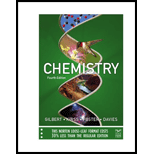
Concept explainers
Interpretation: The standard enthalpy of the given reactions from the appropriate standard enthalpies of formation is to be calculated.
Concept introduction: The energy which is required in a molecule to break one mole of a covalent bond in its gaseous phase is known as bond energy of that bond. It is expressed in terms of enthalpy change denoted by
To determine: The standard enthalpy of the given reaction from the appropriate standard enthalpies of formation.
Answer to Problem 13.76QP
The standard enthalpy of the given reaction is
The standard enthalpy of the given reaction is
Explanation of Solution
The standard enthalpy of formation
The given reaction is,
Standard enthalpy of formation of
Standard enthalpy of formation of
Standard enthalpy of formation of
Standard enthalpy of formation of
The standard enthalpy for the given reaction is calculated by using the formula,
Substitute the values of standard enthalpies of formation of reactants and products in the above formula to calculate the standard enthalpy of the reaction.
Simplify the above equation,
Hence, the standard enthalpy of the given reaction is
The given reaction is,
Standard enthalpy of formation of
Standard enthalpy of formation of
Standard enthalpy of formation of
Standard enthalpy of formation of
The standard enthalpy for the given reaction is calculated by using the formula,
Substitute the values of standard enthalpies of formation of reactants and products in the above formula to calculate the standard enthalpy of the reaction.
Simplify the above equation,
Hence, the standard enthalpy of the given reaction is
The standard enthalpy of the given reaction is
The standard enthalpy of the given reaction is
Want to see more full solutions like this?
Chapter 13 Solutions
Chemistry: The Science in Context (Fourth Edition)
- Show the mechanism steps to obtain the lowerenergy intermediate: *see imagearrow_forwardSoap is made by the previous reaction *see image. The main difference between one soap and another soap isthe length (number of carbons) of the carboxylic acid. However, if a soap irritates your skin, they mostlikely used too much lye.Detergents have the same chemical structure as soaps except for the functional group. Detergentshave sulfate (R-SO4H) and phosphate (R-PO4H2) functional groups. Draw the above carboxylic acidcarbon chain but as the two variants of detergents. *see imagearrow_forwardWhat are the reactions or reagents used? *see imagearrow_forward
- The two pKa values of oxalic acid are 1.25 and 3.81. Why are they not the same value? Show the protontransfer as part of your explanation. *see imagearrow_forwardасть Identify all the bonds that gauche interact with C-OMe in the most stable conformation of the above compound.arrow_forwardPredict the reactants used in the formation of the following compounds using Acid-Catalyzed dehydration reactionarrow_forward
- Can I please get help with this?arrow_forward.. Give the major organic product(s) for each of the following reactions or sequences of reactions. Show ll relevant stereochemistry [3 ONLY]. A H Br 1. NaCN 2 NaOH, H₂O, heat 3. H3O+ B. CH₂COOH 19000 1. LiAlH4 THF, heat 2 H₂O* C. CH Br 1. NaCN, acetone 2 H3O+, heat D. Br 1. Mg. ether 3. H₂O+ 2 CO₂ E. CN 1. (CH) CHMgBr, ether 2 H₂O+arrow_forwardAssign this COSY spectrumarrow_forward
 ChemistryChemistryISBN:9781305957404Author:Steven S. Zumdahl, Susan A. Zumdahl, Donald J. DeCostePublisher:Cengage Learning
ChemistryChemistryISBN:9781305957404Author:Steven S. Zumdahl, Susan A. Zumdahl, Donald J. DeCostePublisher:Cengage Learning ChemistryChemistryISBN:9781259911156Author:Raymond Chang Dr., Jason Overby ProfessorPublisher:McGraw-Hill Education
ChemistryChemistryISBN:9781259911156Author:Raymond Chang Dr., Jason Overby ProfessorPublisher:McGraw-Hill Education Principles of Instrumental AnalysisChemistryISBN:9781305577213Author:Douglas A. Skoog, F. James Holler, Stanley R. CrouchPublisher:Cengage Learning
Principles of Instrumental AnalysisChemistryISBN:9781305577213Author:Douglas A. Skoog, F. James Holler, Stanley R. CrouchPublisher:Cengage Learning Organic ChemistryChemistryISBN:9780078021558Author:Janice Gorzynski Smith Dr.Publisher:McGraw-Hill Education
Organic ChemistryChemistryISBN:9780078021558Author:Janice Gorzynski Smith Dr.Publisher:McGraw-Hill Education Chemistry: Principles and ReactionsChemistryISBN:9781305079373Author:William L. Masterton, Cecile N. HurleyPublisher:Cengage Learning
Chemistry: Principles and ReactionsChemistryISBN:9781305079373Author:William L. Masterton, Cecile N. HurleyPublisher:Cengage Learning Elementary Principles of Chemical Processes, Bind...ChemistryISBN:9781118431221Author:Richard M. Felder, Ronald W. Rousseau, Lisa G. BullardPublisher:WILEY
Elementary Principles of Chemical Processes, Bind...ChemistryISBN:9781118431221Author:Richard M. Felder, Ronald W. Rousseau, Lisa G. BullardPublisher:WILEY





